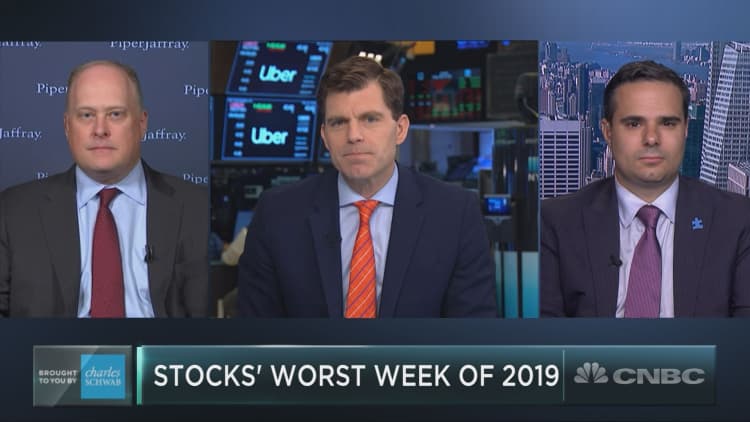
An ordinary market pullback rarely seems routine even when it is. And sudden challenges in the heat of competition aren't described as "gut checks" because they feel good and easy to win.
Yet at this point, last week's jarring stock-index drop of as much as 4% from a record high appears a fairly routine gut check for the bulls — albeit one animated by extraordinary trade-diplomacy-by-tweet and the added anxiety of having come right about where the broad indexes peaked last year before a brutal downturn.
Only two years in recorded market history have not seen at least a 5% dip from the year's high — and one of them came just two years ago. So, the fact that the regressed by 4% by midday Friday before rallying to mute the week's losses can only be viewed as standard market behavior.
Deutsche Bank strategists note that the market typically has a 3-5% shakeout every two to three months, on average, which makes this one seem almost overdue.
So perhaps it's no accident when the squall hit. The 25% rally from the December lows occurred with only minimal setbacks along the way. By the start of May, this action had finally pulled in the professional investor class that had entered 2019 scarred and scared. As noted here last week, the belated embrace of the rally and the upbeat economic signals meant the "pain trade" was no longer to the upside.
The trade war
The China trade-talks impasse and the shaky Uber IPO jolted Wall Street out of an emerging state of complacency, with earnings mostly finished and the Federal Reserve in a rhetorical holding pattern. Only in retrospect will we know if the reescalation of trade frictions was the true "cause" of the "risk-off" spasm last week, or simply a handy excuse.
Wall Street has been living with trade-war static for more than a year, only intermittently finding cause to punish equity values. The real stakes are the implications for China's contribution to world growth or the risk of financial-market stress.
One more-immediate issue presented by the lack of a negotiated deal with China is that it withholds from analysts a convenient opportunity to look for reasons to lift earnings forecasts for coming quarters.
The continued decline in second-quarter projected profits for the S&P — even after three-quarters of all companies beat lowered estimates last quarter — is a nagging headwind to the bullish cause.
This is somewhat mitigated by the fact that the forward one-year price/earnings multiple for the index is not terribly stretched — right at the five-year average of 16.5. And of course, bond yields anchored at the low end of their two-year range with corporate bond spreads benign are a support for valuations.
What's clearer is that the scuttling of a hoped-for trade deal managed to start rebuilding a "wall of worry" that had become fairly short over the prior few months. If not much changes on the fundamental or liquidity front, that's a net positive in forestalling a self-defeating rise in overconfidence among investors.
Of course, if a 4% retreat is purely routine, so would be a somewhat deeper pullback or a prolonged period of queasy choppiness.
Caught in a range?
Last week's column noted that "the most constructive factor in handicapping the market this year has been the behavior of the market itself. It has until now refused to succumb to much profit-taking along the way, limiting dips to about 3% this year."
That's no longer quite the case, and last week saw the gears slipping a bit in what had been a clockwork sector rotation powering a methodical rally.
Further signs of instability popped up in the market for volatility instruments. The near-term Volatility Index (VIX) shot above its nearest VIX futures price — an inversion of the curve that means traders detect higher odds of an immediate shock or unsettled markets. This also can be viewed as a kind of "short squeeze" in volatility itself, as traders who have bet on continued calm are forced to reverse their trades.
By the end of the week, the VIX had deflated enough to undo this inversion, but the moves can serve as a bit of a yellow flashing light for traders for a while after they occur.
The other uncomfortable bit of context for the otherwise routine pullback is the level from which it happened. Here's the broad setup, with lines marking the record high, the January 2018 high (right near Friday's close) and what would be the 5% pullback threshold, just under 2,800.
The new high in the S&P a couple weeks ago was tentative and marginal, coming on low momentum and unimpressive market breadth. Simply observing this chart, the case could be made that for a second time in eight months, sellers pounced and buyers balked as the S&P pushed toward 2,950.
Is this simply an ongoing, wide-swinging trading range? Or was a quick downside break simply needed to flush out some complacency and refresh buying interest at lower prices, in a kind of slingshot move?
On paper, both are plausible. That, as they say, is why they play the games.






